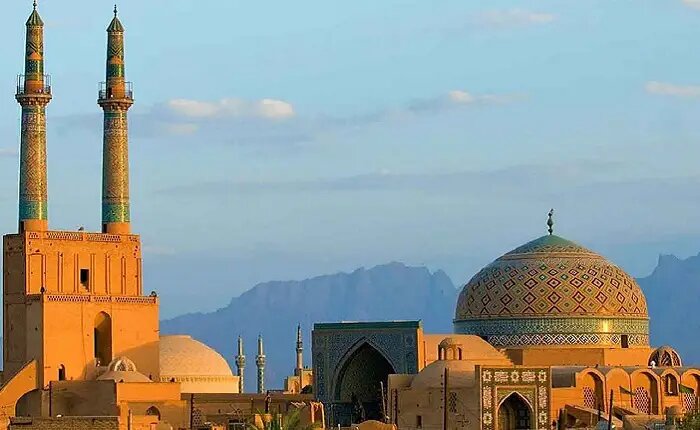Golden Triangle tourism agreement revived

TEHRAN - The “Golden Triangle” tourism agreement, originally signed in 2016, has been revived by the governors-general of the Iranian provinces of Isfahan, Fars, and Yazd.
The renewed agreement aims to strengthen cooperation among these historically rich regions to boost domestic tourism and attract international travelers.
The signing ceremony took place at the Isfahan Governorate on Friday, with the participation of Ali-Asghar Shalbafian, the deputy minister of tourism, and Maryam Jalali-Dehkordi, the Deputy minister of handicrafts, from the Ministry of Cultural Heritage, Tourism, and Handicrafts.
During the meeting, officials emphasized the historical and cultural significance of the three provinces and discussed various strategies to integrate their tourism and handicrafts sectors. Key topics included collaborative promotion efforts, shared tourism infrastructure, and highlighting less-known historical attractions.
A call for regular oversight
Mohammadreza Babaei, the governor-general of Yazd province, stressed the importance of monitoring the progress of the Golden Triangle initiatives and issuing regular reports to ensure the agreement achieves its goals.
Lesser-known attractions
Mehdi Jamalinejad, the governor-general of Isfahan province, underscored the need to move beyond well-known landmarks and to develop lesser-known heritage sites. “We must not limit ourselves to previously introduced attractions but also highlight undiscovered historical treasures,” he said.
The ministry officials also proposed integrating elements of tourism and handicrafts to create a cohesive experience across the three provinces.
Infrastructure and accessibility
The agreement includes plans to enhance infrastructure to improve accessibility between the provinces. Officials hope the efforts will be visible during the upcoming Persian New Year (Nowruz) holidays, facilitating seamless travel for visitors.
The initial Golden Triangle agreement was signed in 2016 among the cities of Isfahan, Yazd, and Shiraz, each a renowned cultural hub. Despite being key destinations individually, limited progress had been made to achieve the envisioned integration. This revival aims to address those gaps and leverage the unique strengths of each city for collective growth.
By combining their resources and focusing on collaboration, the three provinces aspire to transform the Golden Triangle into a world-class tourism route, showcasing Iran’s rich cultural heritage and unparalleled historical sites.
Earlier in October, the mayors of Yazd, Isfahan, and Shiraz signed a trilateral cooperation agreement titled the “Golden Triangle of Iran’s Tourism” in a meeting held in Shiraz. Key points of the agreement included supporting joint research projects aimed at tourism development, utilizing international networks of the three cities, and organizing conferences, workshops, and special visits between them. It also emphasized the identification of human resources and investment opportunities in tourism, as well as the promotion of cultural and artistic programs that highlight the rich heritage of these cities.
Isfahan
Once a crossroads of international trade and diplomacy, Isfahan remains one of Iran’s most prominent tourist destinations. It is renowned for its breathtaking Islamic architecture, including stunning mosques, palaces, and bazaars. Visitors can explore Persian gardens and walk along the city’s tree-lined boulevards, soaking in the beauty and history at every turn. The city’s architectural marvels, such as Naghsh-e Jahan Square—one of the largest squares in the world—make it a jewel of town planning.
Isfahan is known as “Nesf-e-Jahan,” or “half the world,” symbolizing its historic significance. The Zayandeh-Rood River, often called the city’s “life-giving river,” adds to the city’s natural beauty, enhancing its allure for tourists.
Yazd
Situated in the heart of Iran’s desert, Yazd is a city of ancient ingenuity and timeless charm. Known for its maze of winding lanes, traditional bazaars, and mud-brick architecture, Yazd showcases the clever use of limited resources to create a sustainable urban environment. The city’s ancient qanat system—underground channels that transport water from distant mountains—has been the lifeline of this desert city for centuries. Yazd’s historic wind catchers and domed homes maintain cool temperatures in the harsh desert climate, making it an architectural marvel.
The Yazd Water Museum offers a deep dive into the city’s qanat system, giving visitors insight into the nearly 2000-year-old water management techniques that helped this city thrive in the arid landscape.
Shiraz
Known as the heartland of Persian culture, Shiraz has a rich history stretching back over 2000 years. This city is synonymous with poetry, education, and the arts, and has been a hub for creativity and intellectual pursuits. Once the capital of Iran during the Zand dynasty, Shiraz is home to some of the most iconic landmarks in the country, including the Eram Garden, the Tomb of Hafez, and the ancient ruins of Persepolis.
Shiraz’s historical gardens, like Bagh-e Narenjestan and Eram Garden, are masterpieces of Persian landscaping and a top draw for tourists. The city’s enduring connection to Persian culture, coupled with its majestic architecture and natural beauty, continues to make it a prime destination for both domestic and international travelers.
Together, Isfahan, Yazd, and Shiraz represent a “Golden Triangle” of Iranian tourism, each offering a unique glimpse into Iran’s rich cultural, architectural, and historical heritage.
AM
